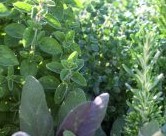 It’s bad enough when the rabbits use your vegetable garden as their private smorgasbord but when they start nipping the herbs maybe it’s time to think about focusing on herbs the rabbits will leave along. Yes, there are some popular herbs that are usually ignored by our furry friends but, of course, there are no guarantees as there may be rabbits that like their lettuce or carrots accompanied by the tender leaves of fragrant herbs.
It’s bad enough when the rabbits use your vegetable garden as their private smorgasbord but when they start nipping the herbs maybe it’s time to think about focusing on herbs the rabbits will leave along. Yes, there are some popular herbs that are usually ignored by our furry friends but, of course, there are no guarantees as there may be rabbits that like their lettuce or carrots accompanied by the tender leaves of fragrant herbs.
Here are herbs that are rabbit resistant:
Chives (Allium schoenoprasus)
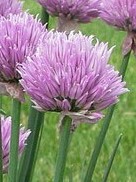 A native of Europe, Asia, and North America, chives are a perennial that can be grown in pots indoors during the winter as well as outdoors during the summer. Its slender blue green leaves can be used to add a mild onion flavor to almost any dish except sweets or decoratively tied around bundles of vegetables such as asparagus. The flowers are pretty in the garden, and are edible so can be used as a garnish or tossed into a salad. They dry well and can be used in arrangements.
A native of Europe, Asia, and North America, chives are a perennial that can be grown in pots indoors during the winter as well as outdoors during the summer. Its slender blue green leaves can be used to add a mild onion flavor to almost any dish except sweets or decoratively tied around bundles of vegetables such as asparagus. The flowers are pretty in the garden, and are edible so can be used as a garnish or tossed into a salad. They dry well and can be used in arrangements.
Height: 1 ½ ‘
Light: Full sun
Soil: Moderately rich, well-drained
Hardiness: Zones 3-9
Mint (Mentha spp.)
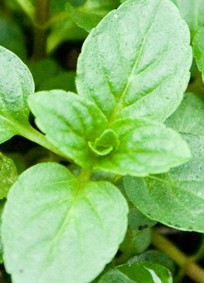 Both spearmint and peppermint tend to be invasive perennials that are best confined. Their square stems bear very aromatic leaves and tiny whorls of tny purple flowers in summer. Peppermint is best for flavoring candies while spearmint is a more versatile flavoring that can be used in numberous dishes inluding vegetables, meat, and beans.
Both spearmint and peppermint tend to be invasive perennials that are best confined. Their square stems bear very aromatic leaves and tiny whorls of tny purple flowers in summer. Peppermint is best for flavoring candies while spearmint is a more versatile flavoring that can be used in numberous dishes inluding vegetables, meat, and beans.
Height: 2’
Light: Full sun to partial shade
Soil: Rich, moist, well-drained
Hardiness: Zones 3-7 (spearmint), 3-10 (peppermint)
Oregano (Origanum vulgare)
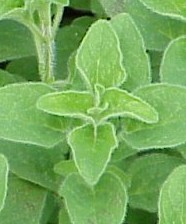 Native to the Mediterranean region, this perennial has aromatic leaves that conjure up visions of pizza. The most difficult aspect of growing oregano is finding the right kind as many of the available seeds or plants taste more like grass than true oregano. One of the best is Greek oregano (O. vulgare subsp. hirtum ). Mexican oregano (Lippia graveolens) is a tasty one but is a tender perennial and best grown as an annual in most areas.
Native to the Mediterranean region, this perennial has aromatic leaves that conjure up visions of pizza. The most difficult aspect of growing oregano is finding the right kind as many of the available seeds or plants taste more like grass than true oregano. One of the best is Greek oregano (O. vulgare subsp. hirtum ). Mexican oregano (Lippia graveolens) is a tasty one but is a tender perennial and best grown as an annual in most areas.
Height: 1-2’
Light: Full sun
Soil: Average, mediummoist, well-drained
Hardiness: Zones 5-10
Rosemary (Rosmarinus offcinalis)
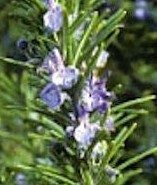 This perennial evergreen shrub is native to the Mediterranean area and is grown for both its ornamental and herbal value. The plants may be sprawling or erect and have grayish-green, leathery leaves 1/3 to 1 ½ inch long. The pale blue flowers ½ inch long grow in clusters o two to three along the branches in summer.
This perennial evergreen shrub is native to the Mediterranean area and is grown for both its ornamental and herbal value. The plants may be sprawling or erect and have grayish-green, leathery leaves 1/3 to 1 ½ inch long. The pale blue flowers ½ inch long grow in clusters o two to three along the branches in summer.
Height:5-6’
Light: Full sun to partial shade
Soil: Lean, light, well-drained
Hardiness: Zones 8-10 (7 with protection)
Sage (Salvia officinalis)
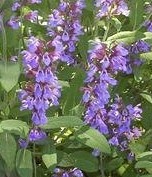 This perennial subshrub is native to the northern Mediterranean coast and has wiry stems that are covered with down. The grayish-green leaves up to two inches long have a seersucker look and are softly hairy. In early summer the tubular ½- ¾ “ flowers appear in leaf axils in whorls of four to eight and are pink, purple, blue, or white.
This perennial subshrub is native to the northern Mediterranean coast and has wiry stems that are covered with down. The grayish-green leaves up to two inches long have a seersucker look and are softly hairy. In early summer the tubular ½- ¾ “ flowers appear in leaf axils in whorls of four to eight and are pink, purple, blue, or white.
Height: 12-30”
Light: Full sun
Soil: moderately rich, dry to medium moisture, well-drained
Hardiness: Zones 4-8
Thyme (Thymus vulgaris)
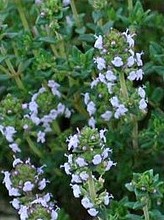 Common thyme is a woody perennial from southern Europe with tiny 1-2-1/2 inch long gray-green leaves that are hairy and have rolled-under edges. The numerous pink to lilac tubular flowers are ¼ inch long and appear in terminal clusters in summer. Thyme is one of the fines herbes of French cuisine and complements a huge number of foods. A sprig of thyme is a beautiful garnish.
Common thyme is a woody perennial from southern Europe with tiny 1-2-1/2 inch long gray-green leaves that are hairy and have rolled-under edges. The numerous pink to lilac tubular flowers are ¼ inch long and appear in terminal clusters in summer. Thyme is one of the fines herbes of French cuisine and complements a huge number of foods. A sprig of thyme is a beautiful garnish.
Height: 1′
Light: Full sun to partial shade
Soil: Light, dry, well-drained
Hardiness: Zones 5-9